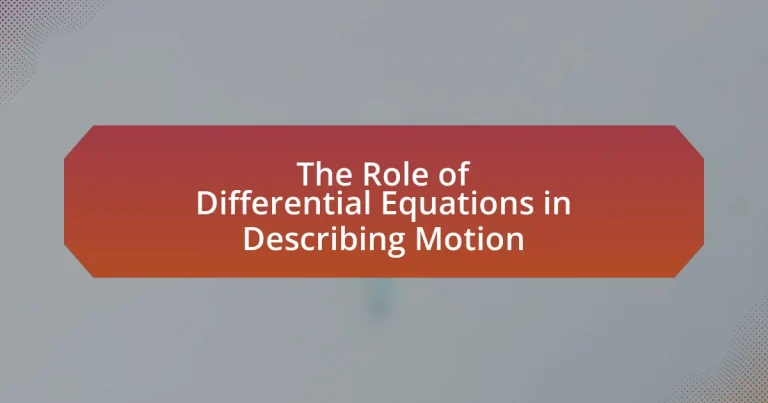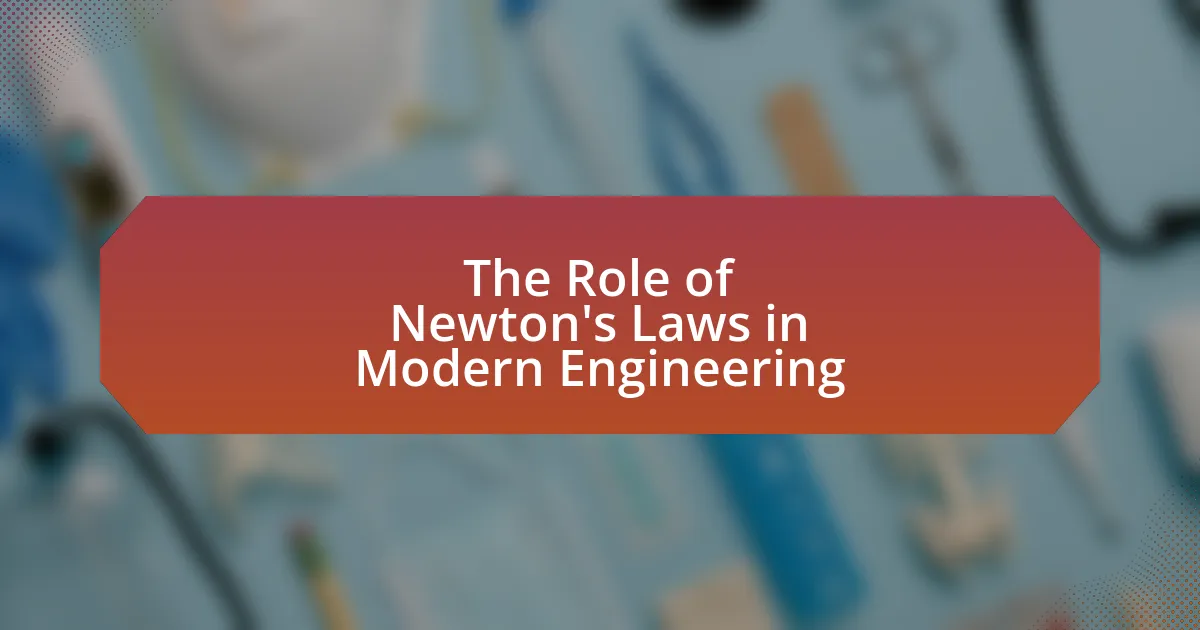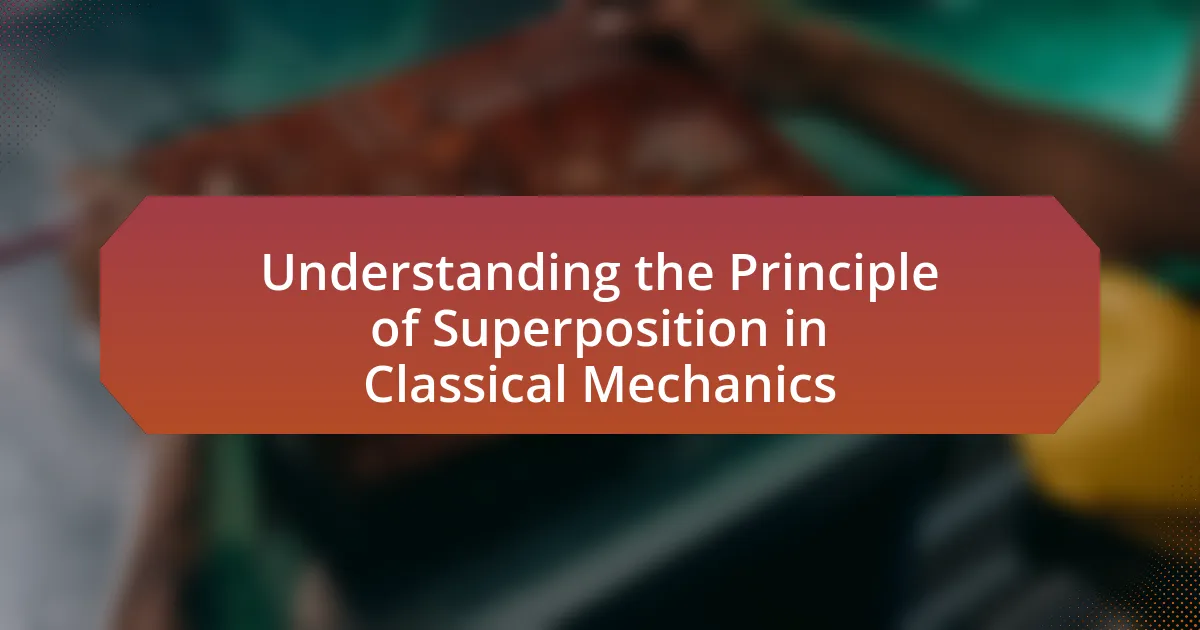Differential equations are mathematical equations that describe the relationship between a function and its derivatives, playing a crucial role in modeling motion by capturing how physical quantities change over time. This article explores the significance of differential equations in understanding dynamics, including their application in classical mechanics, the impact of initial conditions on solutions, and their use in various fields such as physics and engineering. It also addresses the challenges associated with non-linear equations, the importance of numerical methods for solving complex problems, and the future trends in integrating machine learning with differential equations for enhanced motion analysis.

What are Differential Equations and Their Importance in Motion?
Differential equations are mathematical equations that relate a function to its derivatives, representing how a quantity changes over time or space. In the context of motion, they are crucial because they describe the dynamics of moving objects, allowing for the modeling of various physical phenomena such as velocity, acceleration, and forces acting on the objects. For example, Newton’s second law of motion, F = ma, can be expressed as a differential equation, where the force (F) is related to the mass (m) and the acceleration (a), which is the derivative of velocity with respect to time. This relationship enables the prediction of an object’s future position and velocity based on its current state and the forces acting upon it, making differential equations essential for understanding and analyzing motion in physics and engineering.
How do differential equations describe physical phenomena?
Differential equations describe physical phenomena by modeling the relationships between changing quantities, such as position, velocity, and acceleration in motion. These equations express how a system evolves over time, capturing the dynamics of physical processes. For example, Newton’s second law of motion, F = ma, can be represented as a second-order differential equation, where the force acting on an object is related to its mass and the acceleration, which is the second derivative of position with respect to time. This mathematical framework allows for the prediction of future states of a system based on its current conditions, making differential equations essential in fields like physics, engineering, and economics.
What are the basic types of differential equations used in motion?
The basic types of differential equations used in motion are ordinary differential equations (ODEs) and partial differential equations (PDEs). ODEs describe systems with one independent variable, such as time, and are commonly used in classical mechanics to model motion, like Newton’s second law, which can be expressed as a second-order ODE. PDEs, on the other hand, involve multiple independent variables and are used in more complex scenarios, such as fluid dynamics and wave motion, where spatial and temporal changes are significant. These equations are foundational in physics and engineering, providing the mathematical framework to analyze and predict the behavior of moving objects.
How do initial conditions affect the solutions of differential equations?
Initial conditions significantly influence the solutions of differential equations by determining the specific trajectory or behavior of the system being modeled. In mathematical terms, a differential equation describes how a quantity changes over time, and the initial conditions provide the starting values necessary to solve these equations uniquely. For example, in a simple first-order ordinary differential equation like dy/dt = ky, where k is a constant, the solution depends on the initial value y(0). If y(0) is set to a specific number, the solution will follow a particular exponential growth or decay curve defined by that initial condition. This relationship is crucial in applications such as physics and engineering, where precise predictions of motion or system behavior are required. The uniqueness theorem in differential equations states that given a well-defined initial condition, there exists a unique solution to the equation, reinforcing the importance of initial conditions in determining the outcome of dynamic systems.
Why are differential equations essential in modeling motion?
Differential equations are essential in modeling motion because they describe how physical quantities change over time. These equations capture the relationship between a function and its derivatives, allowing for the representation of dynamic systems such as velocity and acceleration. For instance, Newton’s second law of motion, which states that force equals mass times acceleration, can be expressed as a differential equation that relates the position of an object to its velocity and acceleration over time. This mathematical framework enables the prediction of future states of motion based on initial conditions, making it a fundamental tool in physics and engineering for analyzing and simulating motion in various contexts.
What role do they play in classical mechanics?
Differential equations play a crucial role in classical mechanics by providing the mathematical framework to describe the motion of objects. They express the relationships between the quantities involved, such as position, velocity, and acceleration, allowing for the prediction of future states of a system based on its current conditions. For instance, Newton’s second law of motion, F = ma, can be formulated as a differential equation, where the force acting on an object is equal to the mass of the object multiplied by its acceleration, which is the second derivative of position with respect to time. This formulation enables the analysis of dynamic systems and the solution of complex motion problems, reinforcing the foundational principles of classical mechanics.
How do they contribute to understanding complex motion scenarios?
Differential equations contribute to understanding complex motion scenarios by providing mathematical models that describe the relationships between changing quantities. These equations allow for the analysis of dynamic systems, such as the motion of objects under various forces, by capturing the rates of change in position, velocity, and acceleration. For instance, Newton’s second law of motion, expressed as a differential equation, relates the force acting on an object to its acceleration, enabling predictions of future motion based on current conditions. This mathematical framework is essential in fields like physics and engineering, where precise modeling of motion is critical for designing systems and understanding phenomena such as projectile motion, oscillations, and fluid dynamics.

How are Differential Equations Applied in Motion Analysis?
Differential equations are applied in motion analysis to model the dynamics of moving objects by describing the relationships between position, velocity, acceleration, and time. These equations enable the prediction of an object’s future position based on its current state and the forces acting upon it, as seen in Newton’s second law of motion, which states that the force acting on an object equals its mass times its acceleration (F=ma). This foundational principle leads to second-order differential equations that can be solved to determine the motion of objects under various conditions, such as gravitational forces or friction. For instance, in the analysis of projectile motion, the equations derived from these principles allow for the calculation of trajectories, optimizing performance in fields like sports science and engineering.
What are the common applications of differential equations in motion?
Differential equations are commonly applied in motion to model various physical phenomena, including the motion of objects under the influence of forces, fluid dynamics, and population dynamics. For instance, Newton’s second law of motion, which states that force equals mass times acceleration, can be expressed as a second-order differential equation that describes how an object’s velocity changes over time due to applied forces. Additionally, in fluid dynamics, the Navier-Stokes equations, which are a set of nonlinear partial differential equations, describe the motion of fluid substances and are crucial for understanding weather patterns and ocean currents. Furthermore, in population dynamics, differential equations model the growth of populations over time, illustrating how factors like birth rates and death rates influence population size. These applications demonstrate the integral role of differential equations in accurately describing and predicting motion in various contexts.
How are they used in engineering and physics?
Differential equations are used in engineering and physics to model and analyze dynamic systems and motion. They describe how physical quantities change over time or space, allowing engineers and physicists to predict behaviors such as velocity, acceleration, and forces acting on objects. For instance, Newton’s second law of motion, which states that force equals mass times acceleration, can be expressed as a differential equation that relates the acceleration of an object to the net force acting on it. This application is crucial in fields such as structural engineering, where differential equations help in analyzing stress and strain in materials, and in fluid dynamics, where they govern the behavior of fluid flow.
What examples illustrate their application in real-world scenarios?
Differential equations are applied in real-world scenarios such as modeling the motion of a pendulum, where the equation d²θ/dt² + (g/L)sin(θ) = 0 describes the angular displacement over time. This equation captures the relationship between gravitational force and the pendulum’s motion, demonstrating how differential equations can predict behavior in mechanical systems. Another example is in population dynamics, where the logistic growth model, represented by the equation dP/dt = rP(1 – P/K), illustrates how populations grow over time, incorporating factors like carrying capacity and growth rate. These applications show the critical role of differential equations in accurately modeling and predicting motion and change in various fields.
How do numerical methods aid in solving differential equations for motion?
Numerical methods aid in solving differential equations for motion by providing approximate solutions when analytical solutions are difficult or impossible to obtain. These methods, such as Euler’s method, Runge-Kutta methods, and finite difference methods, allow for the simulation of motion by discretizing time and space, enabling the calculation of trajectories and velocities over time. For instance, the Runge-Kutta method offers a systematic approach to solving ordinary differential equations, yielding accurate results for complex motion scenarios, such as projectile motion or oscillatory systems. This effectiveness is evidenced by their widespread use in engineering and physics, where real-world problems often involve non-linear dynamics that cannot be solved analytically.
What are the most popular numerical techniques used?
The most popular numerical techniques used include the Euler method, Runge-Kutta methods, and finite difference methods. These techniques are widely employed for solving ordinary and partial differential equations, particularly in the context of motion analysis. The Euler method provides a straightforward approach for approximating solutions by using tangent line slopes, while Runge-Kutta methods offer higher accuracy through multiple evaluations of the function at each step. Finite difference methods discretize differential equations, allowing for the numerical solution of complex problems in motion dynamics. These techniques are validated by their extensive application in engineering and physics, demonstrating their effectiveness in modeling real-world motion scenarios.
How do these methods compare to analytical solutions?
Numerical methods and analytical solutions differ significantly in their approach to solving differential equations. Numerical methods provide approximate solutions through computational algorithms, making them suitable for complex problems where analytical solutions are difficult or impossible to obtain. For instance, numerical methods like the Runge-Kutta method can handle non-linear equations and systems with variable coefficients, which often lack closed-form analytical solutions. In contrast, analytical solutions yield exact results and are typically derived for simpler, well-defined problems, such as linear ordinary differential equations. The effectiveness of numerical methods is evidenced by their widespread use in engineering and physics, where real-world scenarios often involve complexities that analytical methods cannot address.

What Challenges Exist in Using Differential Equations for Motion?
Using differential equations for motion presents several challenges, including complexity in solving non-linear equations, the need for accurate initial and boundary conditions, and difficulties in modeling real-world scenarios. Non-linear differential equations often lack analytical solutions, requiring numerical methods that can introduce errors. Accurate initial and boundary conditions are crucial, as small inaccuracies can lead to significant deviations in results. Additionally, real-world motion often involves factors like friction and air resistance, complicating the equations and making them harder to solve. These challenges highlight the limitations and intricacies involved in applying differential equations to motion analysis.
What are the limitations of differential equations in motion modeling?
Differential equations in motion modeling have limitations, including their inability to accurately represent complex, nonlinear systems. These equations often assume linearity and constant parameters, which can lead to oversimplifications in real-world scenarios where forces and interactions are variable. For instance, in chaotic systems like weather patterns or turbulent fluid flows, the assumptions made in differential equations can fail to capture the underlying dynamics, resulting in significant errors in predictions. Additionally, the requirement for initial and boundary conditions can restrict their applicability, as obtaining precise conditions is often challenging in practical situations.
How do approximations affect the accuracy of motion predictions?
Approximations can significantly reduce the accuracy of motion predictions by simplifying complex differential equations that govern motion. When approximations are applied, they often ignore certain variables or assume linear relationships, which can lead to discrepancies between predicted and actual motion. For instance, in the study of projectile motion, neglecting air resistance through approximation can result in predictions that deviate from real-world trajectories. Research has shown that using more precise models, such as those incorporating non-linear dynamics, yields predictions that align more closely with observed data, thereby demonstrating that the fidelity of motion predictions is directly tied to the accuracy of the approximations used.
What complexities arise in non-linear motion equations?
Non-linear motion equations introduce complexities such as sensitivity to initial conditions, multiple equilibrium points, and the potential for chaotic behavior. These characteristics arise because non-linear systems do not follow a straightforward superposition principle, making their solutions highly dependent on initial parameters. For instance, in a non-linear pendulum, small changes in initial angle can lead to vastly different trajectories, illustrating sensitivity. Additionally, non-linear equations can exhibit multiple solutions for the same set of initial conditions, complicating predictions and analyses. The chaotic behavior observed in systems like weather patterns further exemplifies the unpredictable nature of non-linear dynamics, where small variations can lead to significant changes over time.
How can one overcome challenges in applying differential equations?
One can overcome challenges in applying differential equations by utilizing systematic approaches such as breaking down complex problems into simpler components, employing numerical methods, and leveraging software tools for computation. For instance, when faced with a nonlinear differential equation, one can apply linearization techniques to simplify the problem, making it more manageable. Additionally, numerical methods like the Runge-Kutta method provide practical solutions when analytical solutions are difficult to obtain. The use of software such as MATLAB or Mathematica can facilitate the solving of differential equations, allowing for visualization and analysis of solutions. These strategies are supported by educational resources and research that emphasize the importance of practice and familiarity with various techniques in mastering the application of differential equations in real-world scenarios.
What best practices should be followed in modeling motion?
Best practices in modeling motion include using differential equations to accurately represent the dynamics of the system, ensuring that the equations account for all relevant forces and constraints. This approach allows for precise predictions of motion by incorporating factors such as acceleration, velocity, and external influences. For instance, Newton’s second law, F=ma, serves as a foundational principle in deriving these equations, demonstrating the relationship between force, mass, and acceleration. Additionally, validating models through empirical data enhances their reliability, as seen in studies where simulations align closely with experimental results, confirming the effectiveness of the chosen modeling techniques.
How can technology enhance the solving of differential equations?
Technology enhances the solving of differential equations through advanced computational tools and software that facilitate numerical methods and symbolic computation. For instance, software like MATLAB and Mathematica allows users to implement algorithms that can solve complex differential equations that are analytically intractable. These tools utilize numerical techniques such as finite difference methods and Runge-Kutta methods, which provide approximate solutions with high accuracy. Additionally, the use of computer algebra systems enables symbolic manipulation of equations, allowing for the derivation of general solutions and simplifications that would be cumbersome by hand. The integration of these technologies has significantly accelerated research and applications in fields such as physics and engineering, where differential equations are essential for modeling motion and dynamic systems.
What are the future trends in the use of differential equations in motion analysis?
Future trends in the use of differential equations in motion analysis include the integration of machine learning techniques to enhance predictive modeling and real-time analysis. As computational power increases, researchers are increasingly applying numerical methods and simulations to solve complex differential equations that describe motion in dynamic systems. This trend is supported by advancements in data acquisition technologies, which provide high-resolution motion data that can be modeled more accurately using differential equations. Additionally, interdisciplinary approaches combining physics, engineering, and computer science are expected to lead to more sophisticated models that can account for non-linear dynamics and chaotic systems, thereby improving the accuracy of motion predictions in various applications such as robotics, biomechanics, and aerospace engineering.
How is machine learning influencing the application of differential equations?
Machine learning is significantly influencing the application of differential equations by enabling more efficient and accurate solutions to complex dynamical systems. Traditional methods for solving differential equations can be computationally intensive and may not capture all the nuances of real-world phenomena. Machine learning algorithms, particularly neural networks, can approximate solutions to differential equations by learning from data, thus providing faster and often more precise results. For instance, research by Raissi et al. (2019) in “Physics Informed Neural Networks” demonstrates how neural networks can be trained to solve partial differential equations by incorporating physical laws directly into the learning process, leading to solutions that are both data-driven and consistent with the underlying physics. This integration of machine learning with differential equations enhances modeling capabilities in fields such as fluid dynamics, climate modeling, and engineering, where traditional methods may fall short.
What advancements in computational methods are on the horizon?
Advancements in computational methods on the horizon include the development of more efficient algorithms for solving differential equations, particularly in the context of simulating motion. These advancements are driven by the need for faster computations and improved accuracy in modeling complex systems. For instance, machine learning techniques are increasingly being integrated with traditional numerical methods to enhance the solution of partial differential equations, which are crucial for accurately describing motion in various physical contexts. Research indicates that hybrid approaches combining deep learning with finite element methods can significantly reduce computational time while maintaining high fidelity in simulations, as demonstrated in studies published in journals like the Journal of Computational Physics.
What practical tips can enhance understanding of differential equations in motion?
To enhance understanding of differential equations in motion, one practical tip is to visualize the equations through graphical representations. Graphing solutions helps in comprehending how variables interact over time, which is crucial in motion analysis. For instance, plotting position, velocity, and acceleration as functions of time can clarify the relationships defined by the equations. Additionally, utilizing simulation software, such as MATLAB or Python libraries, allows for dynamic modeling of motion scenarios, providing immediate feedback on how changes in parameters affect outcomes. This hands-on approach reinforces theoretical concepts and aids in grasping complex behaviors described by differential equations.




